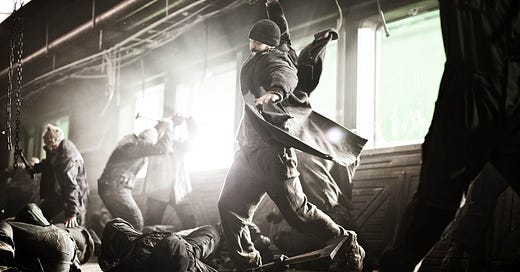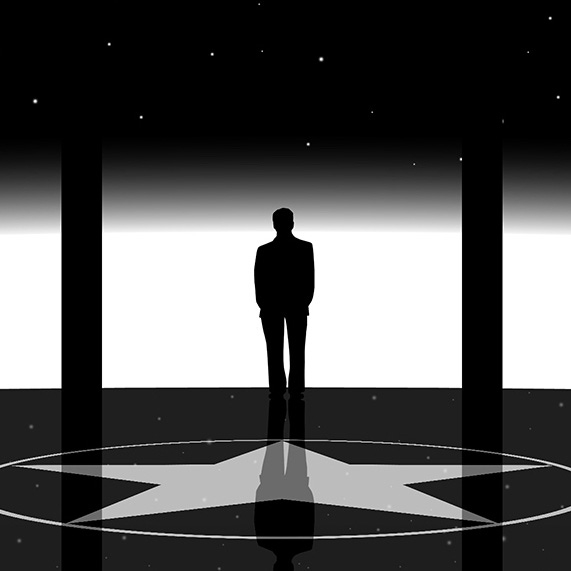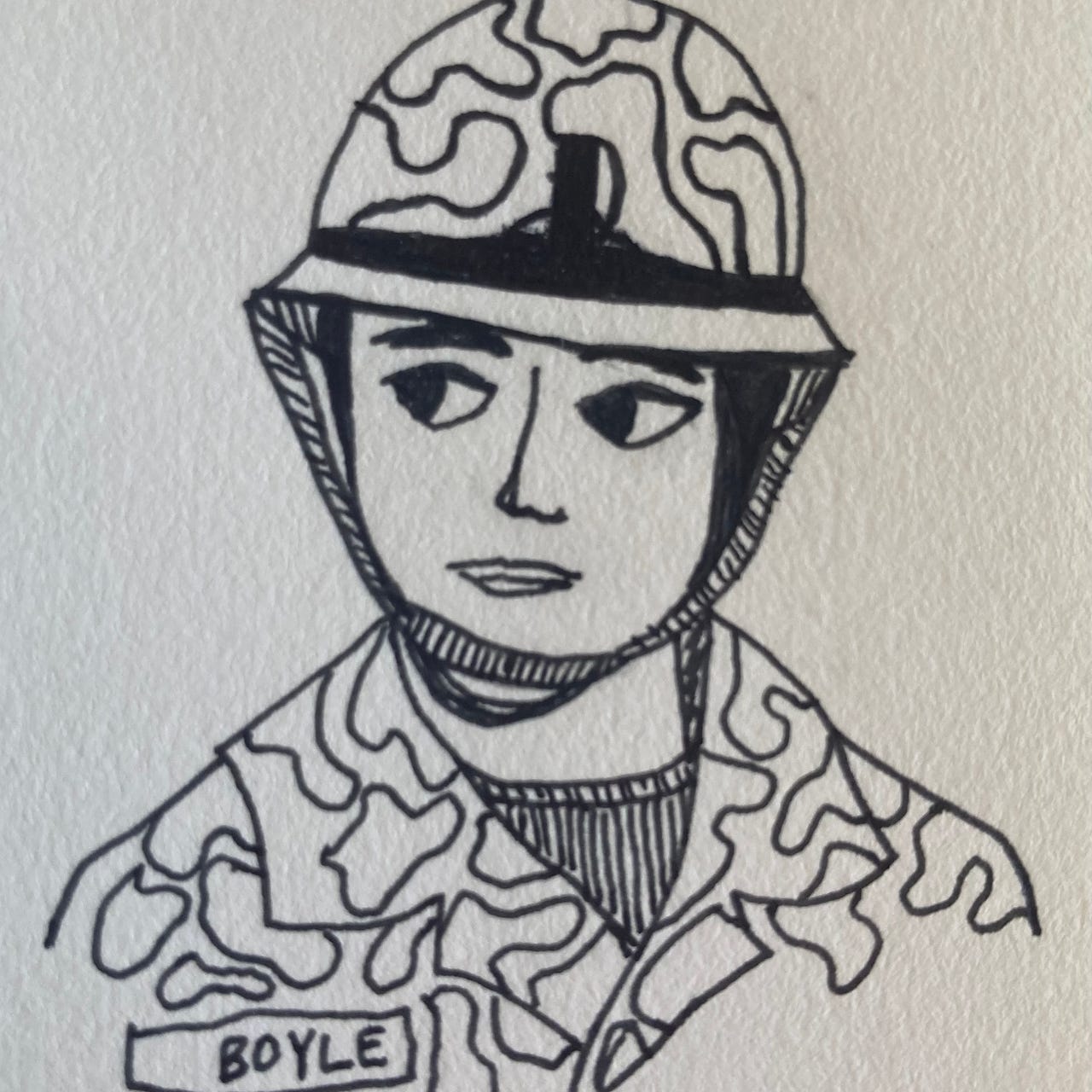So what is “Marx Goes to the Movies” all about? Simply put, it will be a recurring series of posts where, in each installment, I analyze a film (or a streaming series) for its engagement with Marxist theories.
More than mere engagement, a movie or TV series will be examined for its application of ideas from Marx. That is to say, does this piece of filmic art bring real revolutionary potential to the screen? Does it pack enough of a Marxist punch to prod viewers into thinking about—and even rethinking—their cultural bubble?
For Installment #1 of “Marx Goes to the Movies,” we’ll take a look at what I consider to be a rather amazing film: Snowpiercer (2013).
But first, to set the scene, we need a dollop of Marxist theory.
A Dollop of Marxist Theory
Basic Marxist theory (see here and here) holds that the economic base of a society—that is, the “means of production,” how material things get manufactured and how the financial system functions—shapes the cultural superstructure of that society—that is, the politics, law, education, religion, art, literature, customs, and so forth. In this way, the economic structure of a society determines the individual agency of the people living within it. That is, how we behave is largely defined and controlled by the kind of political economy into which we happen to be born.
Moreover, class conflict is inevitable in a differentiated economic system—that is, in any society where there are richer “upper” classes and poorer “lower” classes. In our capitalistic era, which has been chugging along for about three or four hundred years now in various manifestations, that class conflict is marked by, in Marx’s view, the oppression of the lower classes (workers, the proletariat, wage slaves) by the upper class owners of the means of production (bosses, the bourgeoisie, fat cats). Additionally, the social power the bourgeoisie holds over the proletariat is maintained by a combination of force (police, military, economic) and ideology (false consciousness in Marx’s terms).
Now that these basic ideas of Marxist theory have been reviewed, let’s consider a key debate among Marxist theorists. Namely, the relationship between the economic base and the cultural superstructure.
Some Marxist thinkers contend that there is a only a one-way influence running from the base to the superstructure. That is, culture is wholly a reflection and puppet of the economic structure. Thus the owners of the means of production maintain absolute control over the collective life and beliefs of a society. When it comes to literature and art, then, such expressions can only support the status quo and they are little more than elitist propaganda. This school of Marxist thought is known as Reflection Theory. Often it is also referred to as vulgar Marxism.
Other Marxist thinkers contend that there is a two-way influence running between the base and the superstructure. That is, culture is not just a slavish reflection of the means of production (although much of culture is exactly that; just consider nonsense like Undercover Boss, Fox News, or Downton Abbey). Instead, elements of the superstructure can influence and, indeed, work to change the status quo of the economic system. When it comes to literature and art, then, such expressions can be far more than elitist propaganda. Art can be a stimulus for social change, even an instrument of revolution. This school of Marxist thought is known as Production Theory.
And, yes, you guessed it. I’m squarely in the Production Theory camp. Otherwise, what would even be the point of talking about culture?
So let’s take a Production Theory look at Snowpiercer.
Marxist Allegory & Rant & Speculative Satire
This wonderfully off-the-wall film by Joon-ho Bong qualifies not only as a potent Marxist allegory, but as a first-rate Rant in movie form. Bong sets his tale in the post-apocalyptic landscape of the Earth frozen solid due to not just the folly of climate change, but also our stupid pursuit of “a revolutionary solution to mankind’s warming of the planet” in the form of a substance called “CW-7.” By releasing this stuff into the atmosphere, scientists plan to bring “average global temperatures down to manageable levels.” Their experiment, however, goes terribly wrong. Worldwide temperatures plummet, killing just about everyone.
Yet the threat of global warming is not the primary warning being issued by the film. The real threat to humanity is what brought us to our climate-related doom: capitalism. Capitalism is the target of the film. In his blending of political commentary, sci-fi, and monster tale, Bong issues a bleak forewarning about where our current-day neoliberal hegemony is taking us—namely, to our collective doom. In this combination of storytelling elements, Snowpiercer qualifies as what I’ve characterized as Speculative Satire.
The telling and terrible irony of Bong’s allegory is that the last surviving remnant of humanity has organized itself into the very social-economic base and superstructure responsible for killing off humanity.
The fanciful super-train, named Snowpiercer, that circles the globe on a yearly loop socially reproduces exactly the class structure and ideology that brought about the global disaster in the first place. When the apocalyptic tale is set, 2031, this Capitalism Express has been in perpetual motion for seventeen years, pathetically going nowhere and appallingly serving no other purpose than preserving and imposing the workings of the neoliberal Regime on the last handful of humans. Indeed, Bong’s central metaphor is that of capitalism as an end-of-history, stasis-making mechanism of pyramidal hierarchy and oppression embodied as this weird train. Within this allegory, the brutal mechanisms of capitalistic domination are on full, bare-knuckled display.
From Sci-Fi Weird to Self-Recognition Grim
Sci-fi often pulls a nasty trick on its audience. While at first seeming to plunk us down in some strange and disorienting time/place/society, sci-fi soon engineers a moment of sober realization. It doesn’t take long for us to see past the fantastical circumstances and arrive at a grim understanding. Namely, that what we’re actually seeing is our own social moment exaggerated to the point where we can perceive it for what it really is: a power structure pretending to be “natural” and “normal.” Sci-fi can be exceedingly good at de-normalizing our normal. At stripping away the illusion of normal so that we can recognize it for the social construct it is—not as the iron-clad universal “Truth” we’ve been trained to believe it is.
Snowpiercer wastes no time in ripping us out of our capitalist comfort zone.
The opening incident of the film, where one of the “tail-sectioners” has his arm frozen off by armed soldiers, alerts us right away to the haves versus have-nots social order of this bizarre train-world. Obviously, underclass rebellion is a problem aboard Snowpiercer. The man is punished for having thrown his shoe at an official who was abducting, without explanation, his child. During his horrendous punishment—which his tail-sectioner car-mates are forced to witness—Minister Mason makes her first appearance. Played with amazing Monty Python-like energy and excess by Tilda Swinton, Mason is the administrator of order on Snowpiercer. Brandishing the offending footwear, she scolds the hoi polloi for their misguided rebellion:
Passengers! This is not a shoe. This is disorder. This is size-10 chaos. This—you see this? This is death. In this locomotive we call home, there is one thing that’s between our warm hearts and the bitter cold. Clothing? Jeans? No: order. Order is the barrier that holds back the cold and death. We must all of us, on this train of life, remain in our allotted stations. We must each of us occupy our preordained particulate positions. ... In the beginning, order was prescribed by your ticket. First bus, economy, and freeloaders like you. Eternal order is prescribed by the Sacred Engine. All things flow from the Sacred Engine. All things in their place. All passengers in their sections. ... When the foot seeks the place of the head, a sacred line is crossed. Know your place! Keep your place! Be a shoe!
At this early point in the movie, we are left with no doubt that the dystopia we see onscreen will be a rhetorical tool to foreground Marxist issues. And, indeed, while the plight of the tail-sectioners is performed with gritty realism, Bong renders the elite passengers riding at the front of the train as ridiculous caricatures of the well-to-do. The wealthy thoughtlessly enjoy all manner of luxury—fresh food, private space, classical music, bars, discos, hair salons, saunas, swimming pools, aquariums, and so on. The blatant comic sarcasm aimed at the rich of course accentuates the sense of socialist outrage generated by the film.
Many More Marxist Moments
Lots of such socialist instances punctuate the plot of Snowpiercer. All of them serve to reveal the gross inequity and harsh injustice of capitalism. For example, the hero of the film, Curtis (Chris Evans), looms large as a Rebel Workingman who violates the strict boundary between the impoverished back of the train and the affluent front of the train. For most of the movie, we identify with Curtis and cheer him on as he wreaks havoc on the “normal” social order of Snowpiercer. However, at the end of the film, we discover that Curtis is in fact a kind of Frankenstein Monster and that his rebellion is far more nuanced—and troubling—than we think.
Curtis has been created by the owner and creator of Snowpiercer, Wilford (Ed Harris). And, just like Victor Frankenstein’s creature, Curtis is enraged by Wilford’s neglect and, as a result, set on revenge. But Bong does not deliver the satisfying proletariat-hero/bourgeois-bad-guy confrontation we hope for and anticipate. Instead—and unlike all action and superhero movies that climax in a cathartic fight between Good and Evil—at the finale of Snowpiercer we’re presented with an extended dinner conversation about social organization. A conversation that becomes a seduction into capitalism.
Held at gunpoint, Curtis unwillingly sits down to a steak dinner prepared by Wilford. At first Curtis is determined to resist, verbally sparring with his host.
Wilford: Do you think my station is without its own drawbacks? It’s noisy. And it’s lonely.
Curtis: Right. Steaks. Plenty of room. This whore to bring you anything you want.
Wilford: Curtis, everyone has their preordained position. And everyone is in their place, except you.
Curtis: That’s what people in the best place say to people in the worst place. There’s not a soul on this train that wouldn’t trade places with you.
Wilford: Would you trade places with me?
Curtis: Fuck you.
Patiently, however, Wilford explains the facts of their situation to Curtis, which seem incontrovertible. They are all prisoners inside this train. The train is a closed ecosystem that must always be kept in balance: air, water, food supply. Most of all, the population must always be kept stable. Such population control, explains Wilford, is the trickiest problem of all:
For optimum balance, however, there have been times when more radical solutions were required. When the population needed to be reduced—rather drastically. We don’t have time for true natural selection. We would all be hideously overcrowded and starved waiting for that. The next best solution is to have individual units kill off other individual units. From time to time, we’ve had to stir the pot, so to speak. The Revolt of the Seven. The McGregor Riots. The Great Curtis Revolution. A blockbuster production with a devilishly unpredictable plot.
Wilford then reveals to Curtis a devastating piece of news: that Curtis’ fellow tail-sectioner Gilliam (John Hurt) and Wilford worked together, staging these “revolutions” when needed. Says Wilford, “Oh, don’t tell me you didn’t know. Gilliam and I—our plan. ... The front and the tail are supposed to work together. He was more than a partner, really. He was my friend.”
Although incredulous, Curtis comes to see that everything he’s done has been part of Wilford’s plan to reduce the population of the tail-section by 74%. Wilford sums up: “And as Gilliam well understood, we need to maintain the proper balance of anxiety and fear, chaos and horror in order to keep life going. If we don’t have that, we need to invent it. In that sense, the Great Curtis Revolution you invented was truly a masterpiece.”
In reaction to these capitalist social-engineering eye-openers, Curtis is crestfallen and shocked to inaction. At this point, Wilford makes his rhetorical move.
Leading his guest to the nose of Snowpiercer and walking the tail-sectioner into the spinning core of the engine, Wilford entices: “Cozy, yes? Peaceful. You are now in her heart. I’ve devoted my entire life to this. The Eternal Engine. It is eternity itself.” In a movie filled with clamor and violence, the stillness of this moment is profound. Wilford leaves Curtis to enjoy it: “Have you ever been alone on this train? When was the last time you were alone? You can’t remember, can you? So please do. Take your time.”
As Curtis stands alone inside the slowly rotating engine, he becomes overwhelmed and falls to his knees. That’s when Wilford pops back up to pitch his offer:
I am old. I want you to take my Station. It’s what you always wanted. It’s what Gilliam wanted too. You must tend the Engine. Keep her humming. Look, Curtis. Beyond the gate. Section after section precisely where they’ve always been and where they’ll always be. All adding up to what? The train. And now the perfectly correct number of human beings. All in their proper places, all adding up to what? Humanity. The train is the world. We the humanity. And now you have the sacred responsibility to lead all of humanity. Without you, Curtis, humanity will cease to exist. You’ve seen what people do without leadership. They devour one another.
Wilford and Gilliam have been grooming Curtis for the job of engineer from the moment he onboarded Snowpiercer as a seventeen-year-old. Far from being a rebel, then, Curtis is an unknowing cog in Wilford’s social mechanism. He will replace Wilford as the authoritarian saving the violent, ridiculous, and pathetic passengers—i.e. humanity—from themselves: “This is what Gilliam saved you for. Curtis. This is your destiny.”
For a moment, Curtis appears to give into Wilford’s temptation, seduced by the Eternal Engine. Fortunately, though, Curtis spots one of the tail-section children abducted at the opening of the film. The little boy is rhythmically at work amid the grinding mechanisms of the locomotive. The sight jolts Curtis back to his workingman self. Enraged that Wilford uses lower-class children for replacement parts, Curtis pummels Wilford then sacrifices his own arm reaching through the turning gears to rescue the boy.
Capitalism as the Monster
The Marxist lesson is clear: the seductive Engine of Capitalism itself is the monster in Snowpiercer. Wilford is no evil genius or willful destroyer of the Good. He’s a deluded industrial capitalist obsessed with trains and merely a devotee of the status quo doing the only thing he knows how to do: maintain the status quo. For him, it is either capitalism or chaos. Moreover, Wilford clearly believes that capitalism is not just the only form of social organization available to humanity, but that it is the socio-economic crown of creation.
Wilford sees capitalism as an endpoint, the end-of-history social structure that will perpetuate itself endlessly. Obviously, he is mistaken. The locomotive clearly is breaking down. Wilford himself admits, “She’s getting sensitive recently.” Parts are wearing out, making it necessary to turn children into mechanical things. These are hardly the traits of “the Eternal Engine.”
Hence all the talk by Wilford and Mason about everyone having “their own preordained position” on the train is nonsense. Passengers are positioned by organizational choice, not by fate. It is at the directive of the wealthy and powerful on the train that the capitalistic class system is replicated.
The entire movie, in fact, is a story of their fanatical efforts—by repression, by deception, by violence—to keep the Capitalism Express on the track. Wilford’s capitalism/chaos binary is a lie. Snowpiercer demonstrates how, as an apparatus of power, capitalism not only fails to keep the violence of chaos at bay, as Wilford would have Curtis believe, but capitalism is itself the source of chaotic violence. Without class violence, capitalism as a system cannot operate.
Thus the film brims with fierce lower-caste suppression of all kinds. Wilford’s train is not an efficiently functioning society rumbling ideally down the rails; it is a chattering, speeding, multi-car charnel house.
Production Theory at Work
As viewers, we are meant to share Curtis’ stark and deepened awakening into the contrivances of capitalism. Bong’s far-fetched morality tale is designed to jolt us out of any facile, partial, and self-serving understanding of our own economic system. The social organization enacted on Snowpiercer is not the only kind of “train” that humanity could be riding. Capitalism is not normal, natural, or inevitable.
What is more, Bong’s bizarre super-train is an apt symbol for our current global socio-economic status quo. The neoliberal elite, partnered with police-state force, have humanity careening down a track of global destruction and self-annihilation. At the end of the movie, Snowpiercer’s supposedly endless journey ends in a spectacular trainwreck. Only a young girl and boy survive, perhaps personifying a new Eve and Adam. However, their chances for survival look slim. Not only are they alone in a frozen world, but we glimpse a polar bear lurking nearby.
The especially bleak forewarning of this speculative satire, then, is that even if we can blast our way off of this insane choo-choo train of capitalism, environmentally it might already be too late.
COMING IN TWO WEEKS: the yellow laughter of speculative satire...
AND DON’T FORGET...
Read some provocative fiction. Check out and subscribe to my other Substack newsletter, 2084 Quartet at:
While you’re at it, read some provocative social commentary. Check out and subscribe to this absolute Substack gem as well:








Kaboom!